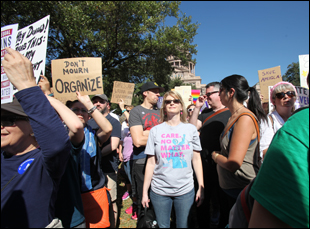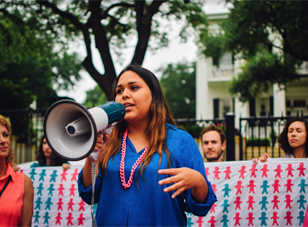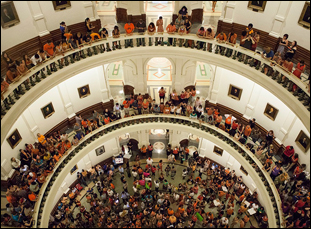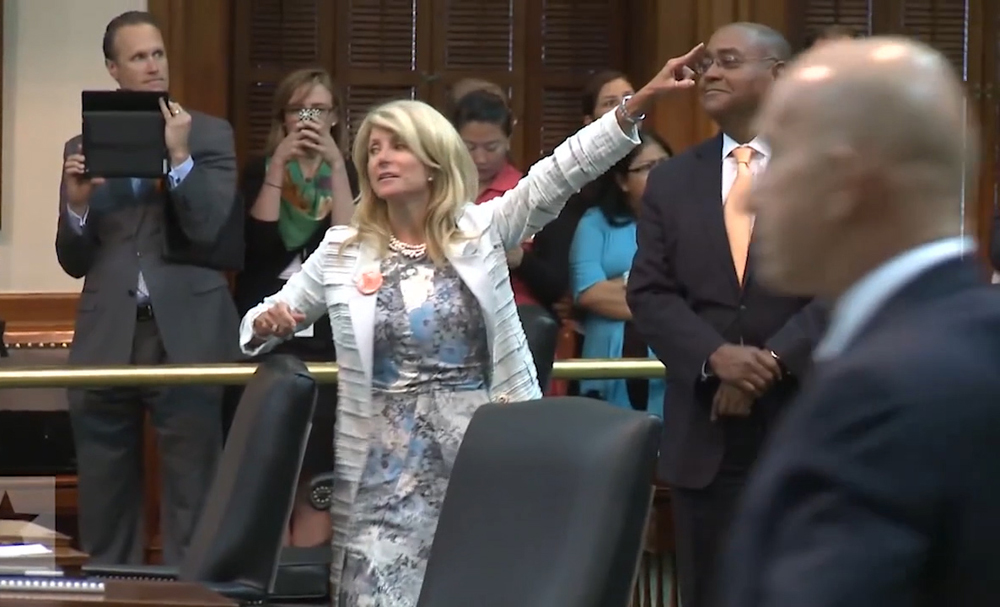For a state that loves to do things big, the Texas Legislature under Republican rule has loved nothing more than to do anything but call attention to itself, taking dry procedural votes on a whole host of measures that have a disquieting impact on those with the least power with only the truly shameless taking credit for the Draconian laws they’ve passed on the feedback loop of local talk radio.
While activists can be counted to come to work outside the Capitol Building in Austin as readily, if not more so, than the state senators who work inside, it was rare for a voice from within to the break the silence as Wendy Davis, a representative from Fort Worth, did when she took to the podium on the evening of June 25, 2013 to attempt to block the passage of a bill that would all but force most of the state’s abortion clinics into closure by asking them to upgrade to surgical centers by staging a nearly 11-hour filibuster in which she wouldn’t be allowed to lean on her desk in front of her or go off-subject in speaking against the bill. Davis, who once braved bullets flying into her office, was undaunted by the challenge and her galvanizing stand, which came to include the reading of letters of women from across Texas who described the pain inflicted by their lack of access to the proper care they needed during their pregnancies, felt as if it was a cinematic nail biter unfolding in real time, with much of the world watching as a livestream from the Senate floor originated by the independent Texas Tribune became a viral sensation.
“Shouting Down Midnight,” a new film from Gretchen Stoltje, recaptures all the electricity of that night, but it goes onto show where all that energy was ultimately channeled, emboldening women throughout Texas to seek political change by organizing grassroots efforts that can’t be ignored by those serving them in office or finding ways to provide access to health care that is increasingly sparse in the state. Both from inside Davis’ own organization Deeds Not Words and beyond, the inspirational echoes of her speech can be shown creating waves as “Shouting Down Midnight” follows Sadie Hernandez, who works tirelessly in Brownsville to raise awareness for all matters of health care in a community where resources have long been deprived, Carole Wall, whose letter was read on the State House floor and is drawn towards a new career path in its wake, and Krithika Shamanna, who starts a free feminine hygiene program at her high school called Launchpad. Although the eventual passage of the bill Davis sought to defeat, as well as its even uglier child, the recent SB8 bill that makes abortions illegal after six weeks, can make all these efforts appear to be pyrrhic victories, Stoltje captures real ones happening in the state that look to lead to even bigger progress.
That’s why the premiere of “Shouting Down Midnight” could feel like a true cause for celebration, even amidst the relentless attack on women’s rights in Texas and as the film made its debut in Austin, Stoltje spoke about the challenge of making a doc that could keep an eye on the future while reflecting all that’s come before in the battle over abortion, finding hope in such a dire situation and embracing the amount of mixed media required to tell this particular story.

That’s so funny, that’s what I thought too. I thought, “Who’s going to make it? Not me.” Like you, I watched the live stream [because] in my day job in the Department of Transportation, [Wendy Davis] was holding up a transportation bill, so we were all being paid to sit there and watch her talk about lady parts while waiting for the transportation bill to come up. It was pretty funny [for that reason], but I think everyone was starting to have this creeping sense of horror and realize that our legislators had already begun shoving us into a dystopian future that I had not noticed and was already going on.
Also I’m a policy dork and I [thought], “That was so dramatic. There was a midnight deadline and three strikes.” I could see that there was something bad going on amongst the legislators that none of them expected and all of a sudden everything got really tense. But besides the crazy suspense narrative of the filibuster itself, the movie I heard was in the letters that [Davis] read because I felt like I heard the history of abortion in this country. I thought, if I can find those people, we can talk about what’s happened over the last hundred years. But I thought, “I’m sure someone’s doing that [movie]. That’s fine.” But then no one did and I thought, “If she wins a governors race I’ll never have access to her, but if she doesn’t, I said to the film, ‘Okay, I will try to make you if she loses.’”
It sounds like you knew the letters would be a core part of this, but because the temptation must be there to create a ticking clock narrative from the filibuster, did you know how to weave those things together from early on?
It’s interesting because I first thought, I want to find those people whose letters she read and I assume we’ll keep the filibuster structure, but tell the rest of that story in flashbacks. But I became interested in people whose lives had been changed by that day and who were going on to do this important social justice work on behalf of other people, so that meant we were moving forward in time, and after a while I thought, I can’t ask audiences to do that much time travel backwards and forwards, so the filibuster is going to have to be first act, then we’ll just follow everybody after that. But the more we tried that, the more we [realized], no one’s going to watch after the midnight climax, but [also] no one’s going to do all that time travel with us, so how can we do that?
I didn’t think we were going to be able to manage it, but my nephew looked at the cut one time and said, “Why don’t you do this?’ And I was like, “That’s what I’ve always wanted to do but I don’t think we can,” and he [insisted], “I don’t know why not.” So we tried it and found a way to make it work, but it took a lot of iterations and a lot of people telling us.

I did start with three or four people whose letters were read and Carole was the one letter writer that I kept following. [Her letter] was the most emotional and the most beautifully written, but also she was the one whose life was really changed by that [night]. Hearing her story read out loud on the Senate floor really lifted a couple of burdens she had from her abortion, one being stigma and she really had some pretty crushing grief about that loss that she was unable to shake, and there was something about that day that released her from that. She started a support group for people with her situation who had a similar abortions and [began] working at Planned Parenthood, so she was the letter writer that I did stick with.
Sadie did her stand in front of the governor’s mansion right across the street from where I worked for 17 days and I would drive around looking for a parking spot and here’s this little short girl with a sign that said, “Honk if you hate cancer,” so I was like, “Who is that?” And I met her at some rally and she said, “I started doing this because I was the filibuster,” and [I thought] “Well, you for president.” I just stayed in touch with her and she graciously allowed me to come down and see her work in the valley. Then Krithika I met through Wendy’s organization Deeds Not Words when they really started to get some traction and created some programs. We were shooting with them in the capital one day and one of the Deeds Not Word staff members said, “You’ve got to meet this high school girl who just called us up the other day. She created a program to have free menstrual products in the bathrooms and we’re going to help her make it a statewide policy.” She was 15 at the time.
Wow. Was it difficult in the edit to balance the ongoing work of these women while building in the historical context around it?
Yeah, that was tough because of course we felt we all know the history of abortion, but we can’t just assume everybody does, so [it was about] how to do that in a way where we weren’t getting all into having to tell those stories. Even with SBA, which is the most recent law that was passed. there’s sometimes in documentaries what we call the “Eat your vegetables” information, all the history that you need to know before you jump into the current story, but [here] where do you put that without taking up too much space once you’ve begun your momentum? With SBA, we started at that rally with people saying, “It’s been bad and it’s getting worse. And we’ve been at this for such a long time and it’s really terrible now.” But we really struggled with whether we need to back ourselves up and say, “What is this bill doing? Why is it so terrible? Because I did feel if I couldn’t back up a claim like everything’s really bad. [we’d ask ourselves] why?” We felt like we were always struggling with how much information to give without burning people out.
I wondered when watching the filibuster footage because you have some from the closed-circuit TV, which is what the world saw, but then there was high-quality scenes directly from the floor. How did you get your hands on that?
The Texas Tribune is actually part of the story because they were there that day and that was the first time they’d ever livestreamed anything, so when I first approached them about using their footage, they were like, “Well, that day put us on the map too.” Apparently the Australian Parliament was projecting the livestream in their session, so [the Tribune] were the ones who had the most footage from that day and the cleanest and the most consistent. I started building that relationship [with the Tribune] before I started shooting my own footage, and they’ve been great to work with. they’ve just been wonderful and really supportive.
The other thing is, mixing all of this footage was really a challenge and one of the rules that the film was going to have to accept for itself was since I couldn’t be all these places and I hadn’t been all these places, it was going to have to be okay with looking like it came from a million places. From the beginning, I liked that in theory because I felt one of the messages of this film is that this was the people’s filibuster, a result of all of these voices and therefore all of these perspectives, so that was one way that I embraced the mixed production value of this film. It should look like it was shot on everything from a HD camera to a flip phone camera. But this is the heaviest archival project I’ve ever done. I’ve always used a little bit of archival here and there in my work but nothing like this, so much of what you see [of] where we couldn’t be, we either found people that we knew who had been there, or we sourced it from archival house or a stock house. That was new for me I had never relied on footage that wasn’t mine in that way at all.

I always knew it would be based in the letters somehow, but I’m mostly surprised that I ended up kind of chasing hope instead of being very gloomy. I thought I’m going to make this really tragic film about the sorry state of abortion law — and it is in a sorry state. But I just was so drawn to the strength, the resilience, the confidence and the empathy of these people who were just really sparked on that day into taking action.
What’s it like to just get it here and start getting it out of the world?
It is just amazing. Austin’s my hometown and South By Southwest is just such an incredibly exciting place to launch a film. I could not be happier. Of course, more importantly everybody [from the film] is here and [the filibuster] happened just up the street from where the film will premiere and I love that proximity. Those guys aren’t in session this year but I hope they hear the outcry. This film can speak to the abortion issue, it can speak to democratic participation and to all kinds of women’s issues and I’m excited that we might be able to travel it to wherever our characters are and wherever the issues are. It’s really exciting and I’m already missing the creative part of the process, but I’m really happy that it’s done.
“Shouting Down Midnight” will screen at SXSW on March 17th at 6 pm at the AFS Cinema.




